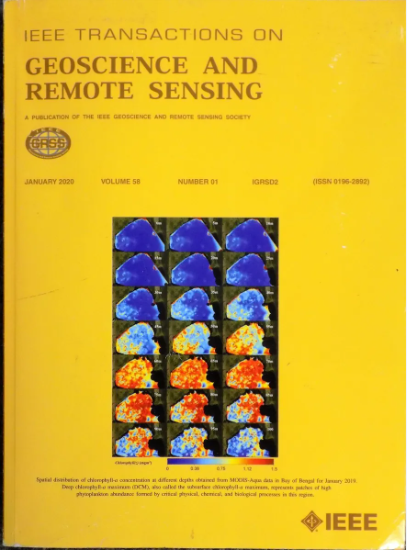Azimuth Estimation Method for Borehole Acoustic Reflection Imaging Using an Acoustic Vector Array
IF 7.5
1区 地球科学
Q1 ENGINEERING, ELECTRICAL & ELECTRONIC
IEEE Transactions on Geoscience and Remote Sensing
Pub Date : 2024-09-17
DOI:10.1109/TGRS.2024.3462435
引用次数: 0
Abstract
Borehole acoustic reflection imaging uses acoustic receivers to detect geological structures but suffers from low accuracies when measuring the azimuths of anomalies. To address this problem, this research proposes an azimuth estimation method based on an acoustic vector array. The acoustic pressure and particle vibration velocity from borehole acoustic reflection imaging are utilized to suppress noise and improve the accuracy of azimuth measurement. The multiazimuth acoustic pressure waveform recorded by the acoustic receiver is synthesized into a multicomponent vibration velocity waveform for which components are paired off and the coordinates are converted to obtain multiple groups of orthogonal components. Subsequently, polarization analysis can be conducted on each group of orthogonal components to obtain the particle polarization direction on the horizontal plane and the vibration velocity waveform of the principal component. The particle polarization direction, amplitude of the multiazimuth acoustic pressure waveform, and type of echo signal can be used to determine the azimuth of an anomaly and obtain its spatial distribution. The proposed method was employed for processing logging data from the field, and the azimuths and spatial distribution of anomalies were obtained. Compared with azimuth estimation using only the amplitude of the multiazimuth acoustic pressure waveform, the proposed method can be used to calculate the incident azimuth with much better measurement accuracy and stability.利用声学矢量阵列进行钻孔声反射成像的方位角估算方法
钻孔声波反射成像利用声波接收器探测地质结构,但在测量异常点的方位角时精度较低。为解决这一问题,本研究提出了一种基于声学矢量阵列的方位角估算方法。利用来自井眼声反射成像的声压和颗粒振动速度来抑制噪声,提高方位角测量的精度。声学接收器记录的多方位声压波形被合成为多分量振动速度波形,其中的分量被配对,坐标被转换,以获得多组正交分量。随后,可对每组正交分量进行极化分析,以获得水平面上的粒子极化方向和主分量的振动速度波形。利用粒子极化方向、多方位角声压波形的振幅和回波信号的类型,可以确定异常点的方位角,并获得其空间分布。利用所提出的方法处理了来自油田的测井数据,并获得了异常点的方位角和空间分布。与仅利用多方位声压波形的振幅估算方位角相比,所提出的方法可用于计算入射方位角,测量精度和稳定性更高。
本文章由计算机程序翻译,如有差异,请以英文原文为准。
求助全文
约1分钟内获得全文
求助全文
来源期刊

IEEE Transactions on Geoscience and Remote Sensing
工程技术-地球化学与地球物理
CiteScore
11.50
自引率
28.00%
发文量
1912
审稿时长
4.0 months
期刊介绍:
IEEE Transactions on Geoscience and Remote Sensing (TGRS) is a monthly publication that focuses on the theory, concepts, and techniques of science and engineering as applied to sensing the land, oceans, atmosphere, and space; and the processing, interpretation, and dissemination of this information.
 求助内容:
求助内容: 应助结果提醒方式:
应助结果提醒方式:


